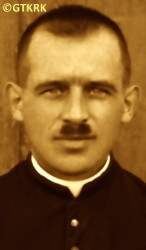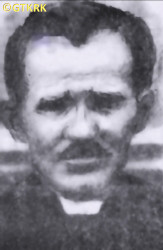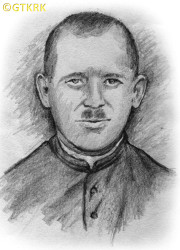Roman Catholic
St Sigismund parish
05-507 Słomczyn
85 Wiślana Str.
Konstancin deanery
Warsaw archdiocese, Poland
full list:
displayClick to display full list

searchClick to search full list by categories
wyświetlKliknij by wyświetlić pełną listę po polsku

szukajKliknij by przeszukać listę wg kategorii po polsku

Martyrology of the clergy — Poland
XX century (1914 – 1989)
personal data
religious status
blessed
surname
TRACKI
forename(s)
Alphonse (pl. Alfons)
religious forename(s)
Gebhard

function
religious cleric
creed
Latin (Roman Catholic) Church RCmore on
en.wikipedia.org
[access: 2014.09.21]
congregation
Brothers of the Christian Schools FSCmore on
en.wikipedia.org
[access: 2014.09.21]
(i.e. Christian Brothers, Lasallian Brothers)
nationality
Polish? German?
date and place
of death
18.07.1946

Shkodërtoday: Shkodër dist., Albania
more on
en.wikipedia.org
[access: 2022.12.10]
alt. dates and places
of death
19.07.1946
details of death
At the beginning of the World War I, returned to his homeland and was drafted into the army of the Austro–Hungarian Empire.
Served for 2 years, prob. fighting on the Balkan front (war with Serbia).
In unknown circumstances, as imprisoned in Gjakova (today's Kosovo) by the Bulgarian army — Bulgarians, fighting on the side of the Central Powers, and therefore also Austro–Hungary, occupied Gjakova in autumn 1915.
Released.
After German and Russian invasion of Poland in 09.1939 and start of the World War II, after start of German occupation of Albania in 1943 managed to secure the release of many Albanians accused of anti–German activities.
After German defeat and start of Communist regime rule in 1944 in Albania — soon religious congregations were banned, church assets confiscated, religious practices forbidden — opposition to Commies attempted to hide in the mountains.
When one of them got serious injured Fr Gebhard was called in for a confession.
Arrested on the spot at the beginning of 1946 by the Commies.
On 13.02.1946 brought to Shodra prison.
Tortured.
On 17.07.1946 sentenced to death and shot next day at 05:00 in the morning behind a local cemetery.
Body was dumped in a ditch filled with calcium…
cause of death
murder
perpetrators
Albanians
sites and events
Ribbentrop‐MolotovClick to display the description, Pius XI's encyclicalsClick to display the description
date and place
of birth
02.12.1896

Bliszczycetoday: Granice gm., Głubczyce pov., Opole voiv., Poland
more on
en.wikipedia.org
[access: 2022.02.14]
parents
TRACKI Joseph
🞲 ?, ? — 🕆 ?, ?

SCHRAMM Martha
🞲 ?, ? — 🕆 ?, ?
religious vows
16.08.1913 (temporary)
presbyter (holy orders)
ordination
14.06.1925

Shkodërtoday: Shkodër dist., Albania
more on
en.wikipedia.org
[access: 2022.12.10]
positions held
till 1946
parish priest — Velipojëtoday: Shkodër dist., Albania
more on
en.wikipedia.org
[access: 2022.12.10] ⋄ RC parish — also: minister in Pulaj village
from 1925
vicar — Shkodërtoday: Shkodër dist., Albania
more on
en.wikipedia.org
[access: 2022.12.10] ⋄ St Stephen RC cathedral parish
till 1925
student — (Bosnia territory)today: Bosnia and Herzegovina
more on
en.wikipedia.org
[access: 2022.12.10] ⋄ philosophy and theology
from c. 1918
friar — Shkodërtoday: Shkodër dist., Albania
more on
en.wikipedia.org
[access: 2022.12.10] ⋄ St Xavier College, Congregation's house, Christian Brothers FSC — prob.
1913 – c. 1914
friar — Shkodërtoday: Shkodër dist., Albania
more on
en.wikipedia.org
[access: 2022.12.10] ⋄ St Xavier College, Congregation's house, Christian Brothers FSC — physical education teacher
1912 – 16.03.1913
novitiate — Viennatoday: Vienna state, Austria
more on
en.wikipedia.org
[access: 2020.07.31] ⋄ Congregation's house, Christian Brothers FSC
1912
accession — Christian Brothers FSC
sites and events
descriptions
Ribbentrop‐Molotov: Genocidal Russian‐German alliance pact between Russian leader Joseph Stalin and German leader Adolf Hitler signed on 23.08.1939 in Moscow by respective foreign ministers, Mr. Vyacheslav Molotov for Russia and Joachim von Ribbentrop for Germany. The pact sanctioned and was the direct cause of joint Russian and German invasion of Poland and the outbreak of the World War II in 09.1939. In a political sense, the pact was an attempt to restore the status quo ante before 1914, with one exception, namely the „commercial” exchange of the so‐called „Kingdom of Poland”, which in 1914 was part of the Russian Empire, fore Eastern Galicia (today's western Ukraine), in 1914 belonging to the Austro‐Hungarian Empire. Galicia, including Lviv, was to be taken over by the Russians, the „Kingdom of Poland” — under the name of the General Governorate — Germany. The resultant „war was one of the greatest calamities and dramas of humanity in history, for two atheistic and anti‐Christian ideologies — national and international socialism — rejected God and His fifth Decalogue commandment: Thou shall not kill!” (Abp Stanislav Gądecki, 01.09.2019). The decisions taken — backed up by the betrayal of the formal allies of Poland, France and Germany, which on 12.09.1939, at a joint conference in Abbeville, decided not to provide aid to attacked Poland and not to take military action against Germany (a clear breach of treaty obligations with Poland) — were on 28.09.1939 slightly altered and made more precise when a treaty on „German‐Russian boundaries and friendship” was agreed by the same murderous signatories. One of its findings was establishment of spheres of influence in Central and Eastern Europe and in consequence IV partition of Poland. In one of its secret annexes agreed, that: „the Signatories will not tolerate on its respective territories any Polish propaganda that affects the territory of the other Side. On their respective territories they will suppress all such propaganda and inform each other of the measures taken to accomplish it”. The agreements resulted in a series of meeting between two genocidal organization representing both sides — German Gestapo and Russian NKVD when coordination of efforts to exterminate Polish intelligentsia and Polish leading classes (in Germany called «Intelligenzaktion», in Russia took the form of Katyń massacres) where discussed. Resulted in deaths of hundreds of thousands of Polish intelligentsia, including thousands of priests presented here, and tens of millions of ordinary people,. The results of this Russian‐German pact lasted till 1989 and are still in evidence even today. (more on: en.wikipedia.orgClick to attempt to display webpage
[access: 2015.09.30])
Pius XI's encyclicals: Facing the creation of two totalitarian systems in Europe, which seemed to compete with each other, though there were more similarities than contradictions between them, Pope Pius XI issued in 03.1937 (within 5 days) two encyclicals. In the „Mit brennender Sorge” (Eng. „With Burning Concern”) published on 14.03.1938, condemned the national socialism prevailing in Germany. The Pope wrote: „Whoever, following the old Germanic‐pre‐Christian beliefs, puts various impersonal fate in the place of a personal God, denies the wisdom of God and Providence […], whoever exalts earthly values: race or nation, or state, or state system, representatives of state power or other fundamental values of human society, […] and makes them the highest standard of all values, including religious ones, and idolizes them, this one […] is far from true faith in God and from a worldview corresponding to such faith”. On 19.03.1937, published „Divini Redemptoris” (Eng. „Divine Redeemer”), in which criticized Russian communism, dialectical materialism and the class struggle theory. The Pope wrote: „Communism deprives man of freedom, and therefore the spiritual basis of all life norms. It deprives the human person of all his dignity and any moral support with which he could resist the onslaught of blind passions […] This is the new gospel that Bolshevik and godless communism preaches as a message of salvation and redemption of humanity”… Pius XI demanded that the established human law be subjected to the natural law of God , recommended the implementation of the ideal of a Christian state and society, and called on Catholics to resist. Two years later, National Socialist Germany and Communist Russia came together and started World War II. (more on: www.vatican.vaClick to attempt to display webpage
[access: 2023.05.28], www.vatican.vaClick to attempt to display webpage
[access: 2023.05.28])
sources
personal:
silesia.edu.plClick to attempt to display webpage
[access: 2019.10.13], sbc.org.plClick to attempt to display webpage
[access: 2019.10.13]
bibliographical:
„Catholic Church in Głubczyce region in 1742‐1945”, Catherine Maler, vol. I and II, with erratum
original images:
commons.wikimedia.orgClick to attempt to display webpage
[access: 2019.10.13], www.nowiny.plClick to attempt to display webpage
[access: 2019.10.13], www.voal.chClick to attempt to display webpage
[access: 2019.10.13], www.ssb24.plClick to attempt to display webpage
[access: 2019.10.13]
LETTER to CUSTODIAN/ADMINISTRATOR
If you have an Email client on your communicator/computer — such as Mozilla Thunderbird, Windows Mail or Microsoft Outlook, described at WikipediaPatrz:
en.wikipedia.org, among others — try the link below, please:
LETTER to CUSTODIAN/ADMINISTRATORClick and try to call your own Email client
If however you do not run such a client or the above link is not active please send an email to the Custodian/Administrator using your account — in your customary email/correspondence engine — at the following address:

giving the following as the subject:
MARTYROLOGY: TRACKI Alphonse
To return to the biography press below:
 Click to return to biography
Click to return to biography












